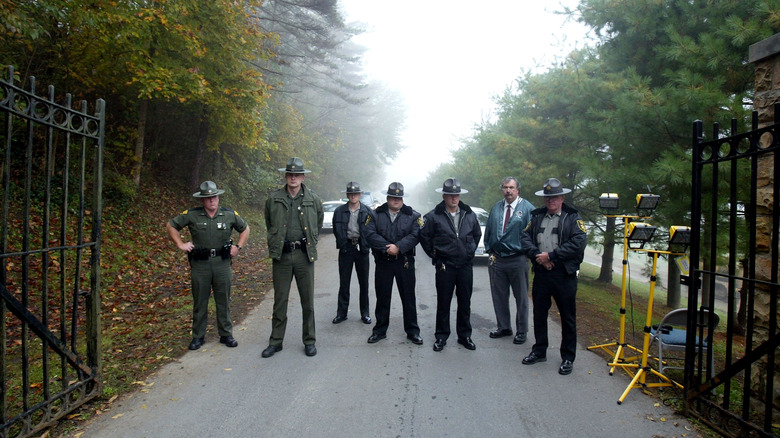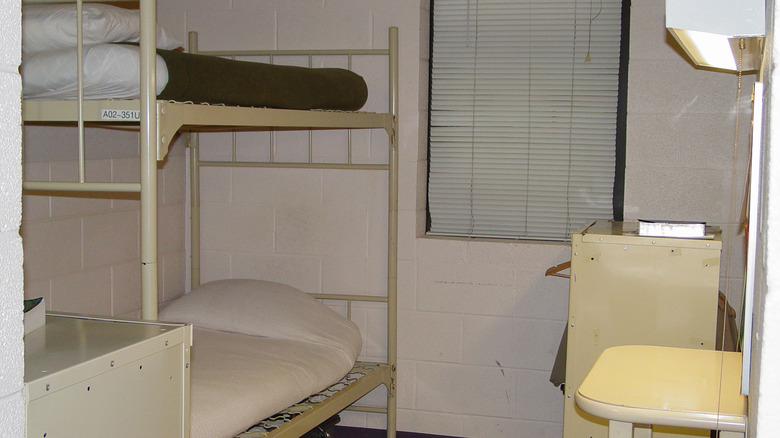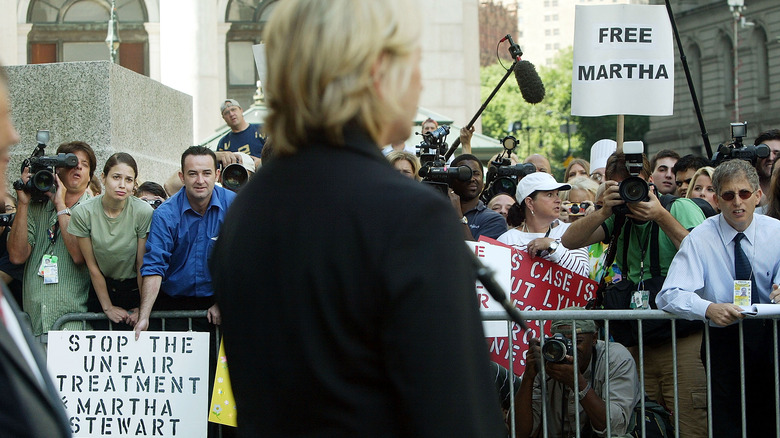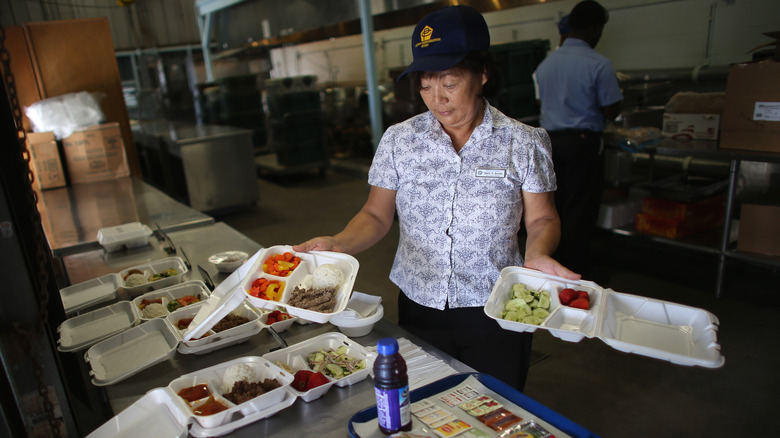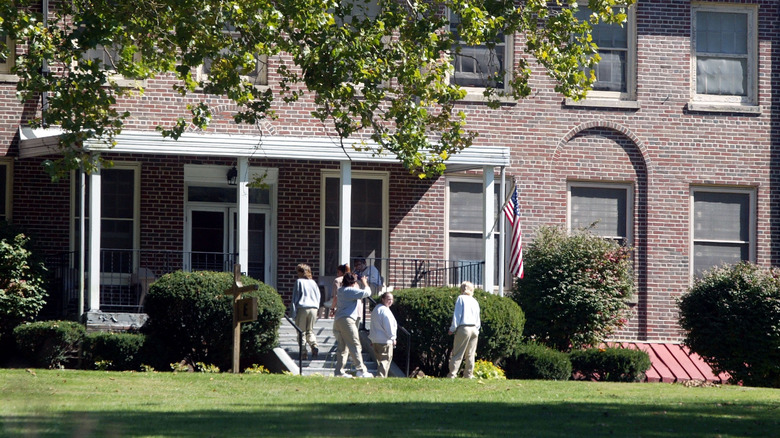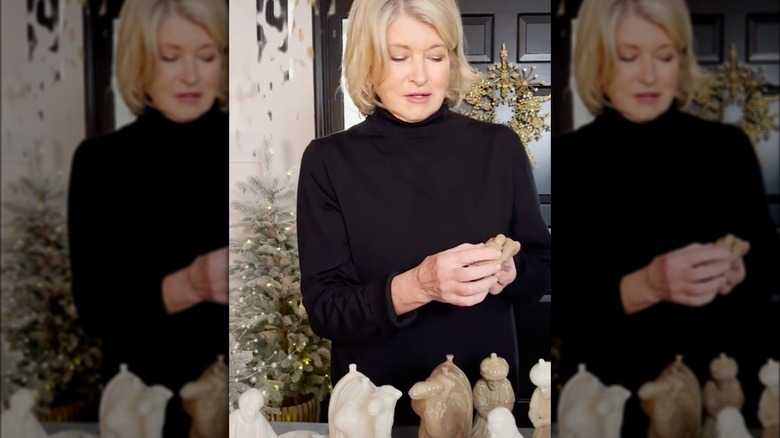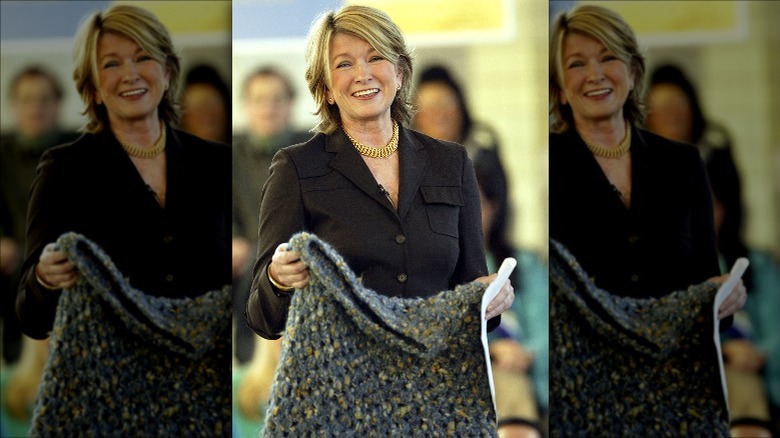What Martha Stewart's Time In Prison Was Like
In 2004, TV icon and cookbook legend Martha Stewart was sent to prison. She had been charged and convicted of a number of financial crimes, and, in the end, spent five months incarcerated at Alderson Federal Prison Camp in West Virginia. She was released in March 2005, and spent a further five months under house arrest at her home in Bedford, New York. Unlike most celebs who end up in the slammer, however, Stewart went on to stage an incredible comeback — and today, it seems like her reputation has hardly been damaged at all by the ordeal.
That's the story everyone knows. But what about Stewart's time on the inside? How did she cope in prison? Who did she know? And, most importantly... could she cook while she was there? From the strange highs to the arduous lows; from day one to day 209 (and beyond), this is the truth about Martha Stewart's time behind bars.
Here's what landed Martha Stewart in jail
Martha Stewart has been an American icon for decades; practically everyone with a kitchen knows her name. So just why did she end up in prison in the first place?
Well, it has to do with insider trading. In 2001, a biopharmaceutical company called ImClone got itself into a bit of a hot spot when it failed to get FDA approval for a new experimental drug it was developing. One of the company's founders, Dr. Samuel Waksal, advised friends and family to sell their stock in the company, knowing its value would take a dive once the news became public. As it happened, Martha Stewart sold 4,000 shares in ImClone stock the day before the FDA announced they had rejected the company's new drug — and managed to save herself a cool $45,000. But things like this don't go unnoticed, and Stewart quickly came under investigation by the U.S. Government.
Stewart was charged with securities fraud, obstruction of justice, and conspiracy, and the case went to trial in early 2004. Funnily enough, she wasn't actually convicted for the financial crimes (although she did have to pay $195,000 in a subsequent civil case). No, Stewart actually went down for the conspiracy, obstruction of justice, and for lying to investigators — she had insisted that she had an agreement with her stock broker to sell shares if they dropped below a certain price. Stewart was sentenced to five months in prison, five months of house arrest, and two years probation.
Martha Stewart served her time at Camp Cupcake
Although Martha Stewart asked to be incarcerated in Connecticut or Florida, so her elderly mother could visit her, she was sentenced to carry out her term behind bars at FCP Alderson in West Virginia.
Known as "Camp Cupcake," FCP Alderson is said to be "America's cushiest prison." It's a 159-acre minimum-security prison camp, located near Alderson, West Virginia, which sits on the banks of the Greenbrier River. FCP Alderson was built in 1928 as the first federal prison for women, and employs a "reformatory" model of justice in which no barbed wire is used and the inmates are housed in so-called "cottages" that can house up to 60 other women.
Inside, inmates are given access to email, a television room, library, hospital, chapel, education building, and a common area. Inmates spend most of their time working, but they're also able to take part in apprenticeship programs for teacher assistants, cooks, electricians, and other similar professions. When they're not working, they're allowed to pretty much come and go as they please — as long as they sign out and explain where they're going, inmates are allowed to exit their cottages and walk around the grounds at any time after morning count and before 4 p.m.
Doesn't sound too bad, does it?
The prison that housed Martha Stewart may have had a dark side
According to an article published by Talk Poverty in 2015, FPC Alderson is no Camp Cupcake at all. Written by Evie Litwok, an ex-inmate at the prison, it sheds a different light on the prison in which Martha Stewart was incarcerated. Litwok's account of FPC Alderson is one of ill-fitting uniforms, backbreaking work, and prisons being frequently refused the opportunity to relax or socialize. But that wasn't even the worst of it — not by a long shot.
"My first job at the Alderson kitchen was cleaning floors after the lunch and dinner shift. Although I worked seven or eight hours a day, I earned only $5.25 during my first month," she writes on the PrisonTalk forum. "And after our work was done, we were not permitted to go back to the unit between lunch and dinner. We were not allowed to read, do crossword puzzles, knit, play cards, or sleep."
Litwok even shed some light on Stewart's own time at FPC Alderson, suggesting that the TV personality was singled out and humiliated by prison staff. "In Alderson, everyone was required to work in the kitchen for their first 90 days," Litwok explains. "That is, everyone but Martha Stewart, who requested but was denied kitchen duty. I suspect she was refused because this chore might have given her an inkling of pleasure within the miserable prison environment. She was instead assigned instead to the humiliating task of mopping the floors and cleaning the toilets of the warden and other higher-ups."
Martha Stewart gave a Christmas update from prison
On December 22nd, 2004, Martha Stewart posted a note on her website, offering fans an update on her time behind bars. Stewart insisted that she was doing "fine" in prison. "I look forward to being home," she wrote, "to getting back to my valuable work, to creating, cooking, and making television. I have had time to think, time to write, time to exercise, time to not eat the bad food, and time to walk and contemplate the future."
She also revealed that her official prison job had been cleaning. "But like everyone else here," Stewart said, "I would rather be doing all of this in my own home, and not here — away from family and friends." At the time, People noted (via CNN) that the celeb homemaker had sat down for Thanksgiving dinner with a convicted cocaine dealer.
Rounding off her note, Stewart voiced the need for America to move towards rehabilitative justice. She wrote:
"I beseech you all to think about these women — to encourage the American people to ask for reforms, both in sentencing guidelines, in length of incarceration for nonviolent first-time offenders, and for those involved in drug-taking. They would be much better served in a true rehabilitation center than in prison where there is no real help, no real programs to rehabilitate, no programs to educate, no way to be prepared for life "out there" where each person will ultimately find herself, many with no skills and no preparation for living."
Martha Stewart did some cooking in prison
Although Martha Stewart may have been denied the chance to take on kitchen duties as a regular work role, she did at least get to spend some of her time in prison cooking. In October 2004, Stewart's lawyer told the media that, because a microwave was pretty much the only cooking utility regularly available to inmates, she was experimenting with making her own microwave meals. (As it happens, Stewart does sometimes post lists of microwave recipes on her site, although it's hard to say how many of them were inspired by her time in the slammer.)
At the same time, Stewart's lawyer also revealed that she had been picking crab apples on the prison grounds. And, sure enough, a New York Post piece (via CNN) reported that she had used those same apples to cook up a sweet, yet technically illicit, jelly. "The normal person would get punished for that," one inmate told the outlet, "but the prison guards managed not to see her."
A spokeswoman for the prison told the Post that it is "unlikely that a prisoner would get into serious trouble for such activity. It's a 105-acre compound with a lot of different trees, and crab apples are amongst them."
Martha Stewart kept fit in prison
It seems pretty clear that Martha Stewart's prison sentence saw its fair share of ups and downs, but one aspect that was heavily reported in late 2004 was that, apparently, it had done wonders for her physical health.
According to People, the celeb had lost 10 pounds by December — just a couple of months into her stint. A visitor told the outlet: "It's just wild. She looks better than ever." A relative of another inmate, who had also presumably spotted Stewart during a visit, said: "That woman is skinny now compared to the pictures of her."
"It was a big relief for all of us to see Martha so healthy, well-adjusted and well-liked," said Laura Plimpton, Stewart's younger sister. "She looks relaxed and feels that the time is passing quickly." Plimpton noted that her sibling had opted out of the prison's standard turkey Thanksgiving dinner, and had instead chosen to cook pasta with olive oil for her and her fellow inmate, Lisa Guarino (the aforementioned cocaine dealer).
But it wasn't just a diet that had Stewart shedding the pounds. Apparently, she was a frequent visitor to the prison's workout facilities, and often took part in abdominal exercises and yoga. And that's to say nothing of the workout she got doing her cleaning jobs. "Cleaning is something she knows how to do and she knows how to do it very, very well," a friend told People. "She doesn't dwell on it, she just does it."
Martha Stewart made friends in prison
Prisons are known for being pretty rough places — especially the more hardcore joints. Luckily, however, FPC Alderson isn't exactly full to the brim with race gangs and mafia kingpins, so inmates are afforded a few more opportunities to make friends than you might find in some of America's more secure facilities.
And as it happens, Martha Stewart herself made far more friends in prison than just Lisa Guarino. In fact, Stewart made a number of pals on the inside, including one group of friends with whom she was still keeping in touch at least three years after her release. "Some of the women who became my friends while I was incarcerated have visited with me," Stewart told Fortune (via Irish Examiner). "There are some very interesting women there of great value to society, and I keep in contact with them. We have some broken systems in this country — one is the prison system."
Friends and family visited Martha Stewart in prison
In October 2004, Martha Stewart's daughter, Alexis, appeared on CNN's "Larry King Live" and shed some further light on her mother's time behind bars. According to Alexis, by far the worst thing about FPC Alderson is the food (via Westport Now). "It's terrible," she said. "I'm sure she could give them quite a few pointers, but I think that the budget is so limited that [...] I'm not sure how much change they'd be willing to make."
Alexis also explained that Stewart was getting up before any of the other inmates, and always ate with them — and also revealed that, because she hadn't been given access to the prison's email system for whatever reason, she was using a typewriter to write to family and friends. Almost every other inmate, Alexis said, had been contacted by journalists in an attempt to dig up dirt on the celeb cook.
Alexis herself had made the eight-hour drive from Manhattan to visit her mother on a number of occasions. "She was having a lot of fun playing Scrabble until I started beating her," she said. "Now she decided she doesn't want to play." But Alexis also explained that, as feared, Stewart's mother had been unable to make the trip to visit.
Finally, Alexis insisted that prison staff were friendly and polite, but had refused to give Stewart any special treatment — in the positive sense, at least.
Martha Stewart also experienced home confinement
On March 4, 2005, Martha Stewart was released from prison. A crowd of fans had gathered outside FPC Alderson to cheer the star on as she left the facility for (hopefully) the last time.
But her sentence wasn't over yet. Stewart also had to make it through five more months of home confinement — and, according to an ABC News report from January 2006, she actually considered house arrest to be worse than prison. "Good Morning America" journalist Matt Tyrnauer had spent some time with Stewart in her home during this period of house arrest. He says that she mostly lived in her kitchen, since most of the rest of her home was unfurnished. She also claimed her electronic monitoring bracelet was uncomfortable, and even admitted she had researched how to remove it on the internet. Worse still, Stewart was only allowed away from her home for 48 hours per week, meaning she couldn't put any time into her then-budding reality show, "The Apprentice: Martha Stewart."
Tyrnauer also pointed out that, if she had the time, she would have been interested in campaigning for reform in the female prison system. Yet, while she has embarked on many different projects since her release from prison, it doesn't look like Stewart ever kept herself to that particular interest.
Martha Stewart's life as a free woman
When Martha Stewart was first sentenced to prison, many asked whether her brand had been tarnished forever. And who could blame them? Many celebrities have had their careers destroyed by the crimes they've committed; even non-violent crimes, such as insider trading. Surely the same could happen to Martha Stewart?
Well, many years later, it's pretty fair to say that it hasn't. Since she was afforded her freedom, Stewart has finished and starred in "The Apprentice: Martha Stewart," written several books, established a hugely successful show in "Martha Stewart Living," set up her own brands of wine and frozen foods, and even became unlikely friends with Snoop Dogg.
Meanwhile, although she was barred from acting as director for her company, Martha Stewart Living Omnimedia, for five years after she stood down in the wake of her trial, she continued to control 50 percent of the company's stock and 90 percent of its voting stock. In fact, during her time in prison, the value of her stock doubled, and she had become a billionaire once more by 2006. Today, she refers to her stint in jail as nothing more than her "horrible legal problem."
Looking back at Martha Stewart's time in prison
In October 2017, Martha Stewart sat down to talk to TODAY anchor Katie Couric on the latter's podcast. Among other things, she spoke about her time in prison — and how she's reflected on it in the years since. And she doesn't have much good to say.
"It was horrifying," Stewart explained, "and no one — no one — should have to go through that kind of indignity, really, except for murderers, and there are a few other categories. But no one should have to go through that. It's a very, very awful thing."
Couric asked whether Stewart had at least found prison to be a "growth experience," and (contrary to some of the reports that came out at the time) the star responded that nothing good whatsoever emerged from her five months at FPC Alderson. "That you can make lemons out of lemonade?" she explained. "What hurts you makes you stronger? No. None of those adages fit at all. It's a horrible experience. Nothing is good about it, nothing."
Stewart further revealed that she had particularly disliked being separated from her family, and "feeling maligned [...] especially when one does not feel one deserves such a thing. I mean, I was not a bad person."
More than anything, Stewart said, she refused to allow her time in prison to define her. "I was a strong person to start with," she said, "and thank heavens I was. And I can still hold my head up high and know that I'm fine."
Martha Stewart took a pottery class
Most of us don't really want to go to prison, but to be honest, Martha Stewart kind of makes it sound fun, at least if you land in white collar crime, low security prison. Last Christmas, Martha took to TikTok to share a ceramic nativity scene she was selling just in time for the holidays. But this wasn't just any nativity scene. What made this particular creche so special is the fact that it was modeled after one she made during a pottery class while she was away at "camp," as Stewart so euphemistically put it. Talk about taking something naughty and turning it into something nice. Santa would be proud — maybe.
According to Harper's Bazaar, the 14-piece ceramic Nativity set was sold on Stewart's website for $120. And as Martha promised in her TikTok, it's the perfect Christmas gift that also comes with "a little street cred." It begs the question: does buying a prison-inspired Nativity scene truly capture the spirit of Christmas? Depends on who you ask.
Martha Stewart got into crocheting
While Martha Stewart was away for five months on felony charges of insider trading, not only did she take part in pottery classes, but she also got into another craft: crochet. When Martha Stewart was released from prison back in 2005, she was photographed rocking a now famous poncho that she said was made for her by a fellow inmate. In fact, she shared with TODAY that, as recently as 2020, the crocheted poncho was still sitting somewhere in her attic.
This poncho came to symbolize Martha Stewart's new post-prison life. At a meeting for her company and shareholders following her 2005 release, Stewart even brought the crocheted creation along to demonstrate the life (and crafting) lessons she'd learned during her time away. Being exposed to new people and their circumstances while being incarcerated helped give her a perspective shift that many newly released inmates experience, according to law professor David N. Zlotnick (via New York Times). Perhaps that's how Stewart managed to so thoroughly revitalize her brand and her image.


